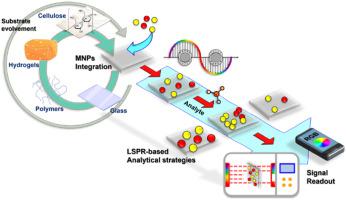Analytica Chimica Acta ( IF 6.2 ) Pub Date : 2022-11-08 , DOI: 10.1016/j.aca.2022.340594 Annalisa Scroccarello 1 , Flavio Della Pelle 1 , Michele Del Carlo 1 , Dario Compagnone 1

|
Noble metal nanoparticles (MNPs), have represented the keystone of a plethora of (bio)sensing analytical strategies because of their unique physicochemical features, becoming unique tools in the analytical scenario; in particular, MNPs localized surface plasmon resonance (LSPR) offers infinite analytical possibilities.
In this work, the scaling-up from colloidal MNPs to their integration in solid substrates is overviewed, and the relative sensing and biosensing optical strategies based on LSPR changes are systematically treated in accordance with the supporting substrate employed. Recent literature and key papers reporting MNPs integration into solid substrates are considered, paying particular attention to the MNPs-based event into/onto the solid support and the related plasmonic change used as analytical signal.
The review is organized in sections according to the solid support nature (glass, polymers, cellulose) and the papers are discussed according to the sensing strategy. The strategies have been classified in MNPs synthesis, growth, etching, displacement/aggregation directly or indirectly mediated by the analyte(s); only works that rely on plasmonic-transduction principles are taken into account, MNPs used as catalysts or in lateral flow systems are not considered.
The review demonstrates that MNPs decorated/integrated substrates are now mature analytical tools, able to overcome the limitations of MNPs colloidal suspensions; this results in new analytical opportunities, particularly the realization of integrated systems, lab-on-chip/lab-on-strip and flexible devices, paving the way for a new generation of plasmonic (bio)sensors for point-of-need applications.
中文翻译:

基于集成在固体支撑物中的纳米材料的光学等离子体传感。批判性评论
贵金属纳米粒子 (MNP) 因其独特的物理化学特性而成为众多(生物)传感分析策略的基石,成为分析场景中的独特工具;特别是,MNPs 局部表面等离子体共振 (LSPR) 提供了无限的分析可能性。
在这项工作中,概述了从胶体 MNP 到它们在固体基质中的整合的放大,并根据所使用的支持基质系统地处理了基于 LSPR 变化的相对传感和生物传感光学策略。考虑了报告 MNPs 集成到固体基板中的最新文献和关键论文,特别注意基于 MNPs 的事件进入/进入固体支持和用作分析信号的相关等离子体变化。
综述根据固体支持物性质(玻璃、聚合物、纤维素)分为几个部分,论文根据传感策略进行讨论。这些策略已被分类为由分析物直接或间接介导的 MNP 合成、生长、蚀刻、置换/聚集;仅考虑依赖等离子体转导原理的工作,不考虑用作催化剂或横向流动系统的 MNP。
审查表明,MNPs 装饰/集成基板现在是成熟的分析工具,能够克服 MNPs 胶体悬浮液的局限性;这带来了新的分析机会,特别是集成系统、片上实验室/条上实验室和柔性设备的实现,为新一代等离子(生物)传感器的需求点应用铺平了道路。



























 京公网安备 11010802027423号
京公网安备 11010802027423号